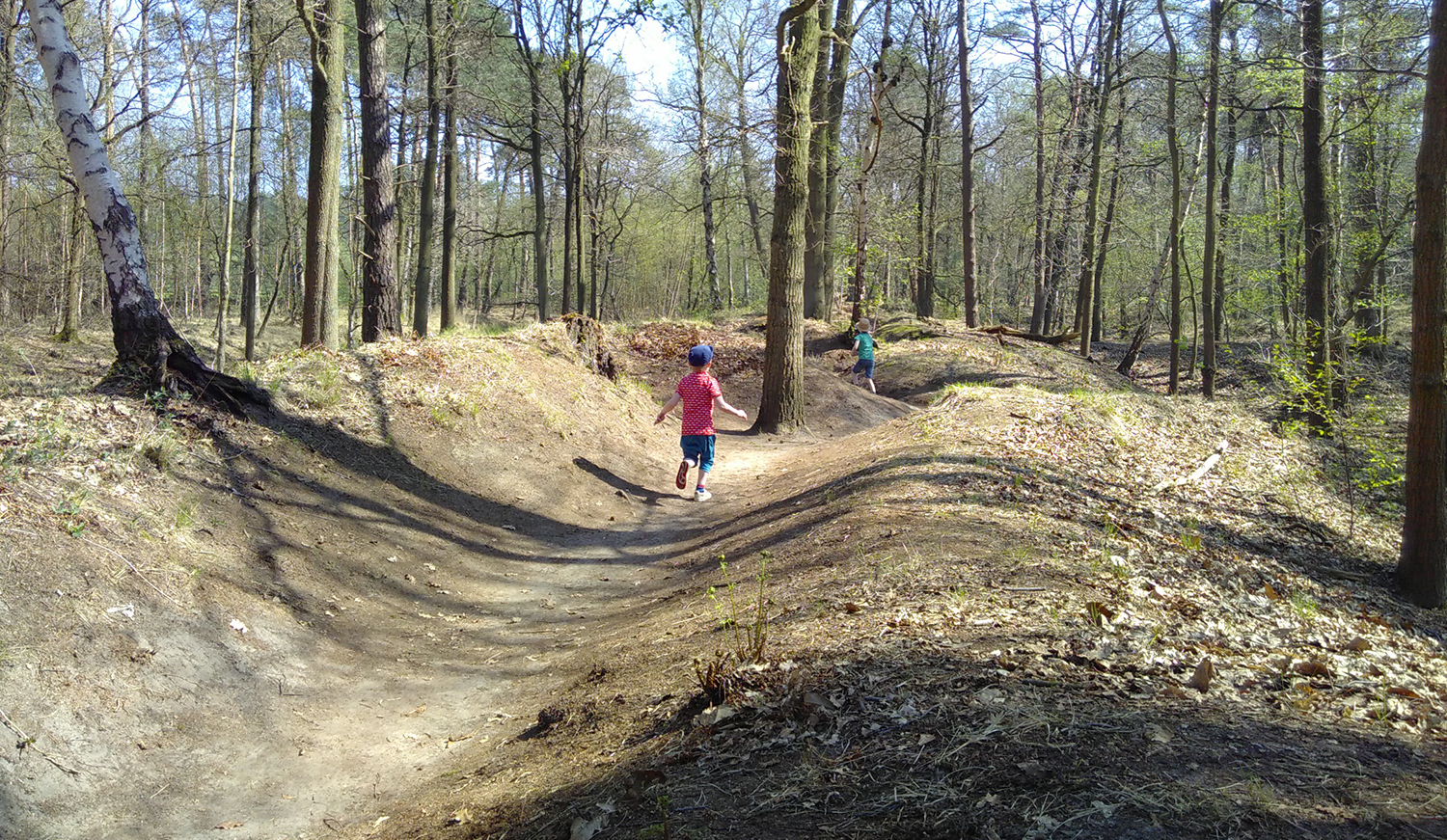
Commandobunker
Tijdens de 19de eeuw bouwden de Belgen in Antwerpen al een fortengordel uit. Vlak voor de Eerste Wereldoorlog bouwden ze in de onverdedigde zones daartussen nog extra versterkingen uit, zoals prikkeldraadversperringen, loopgraven en schuilplaatsen . Na de val van Antwerpen op 10 oktober 1914, besloten de Duitsers al deze fortificaties te recupereren. Ze pasten de oude Belgische linie aan naar hun normen. In 1917 bouwden ze een eigen, zwaar verdedigde stelling uit, ten noorden van Antwerpen op dezelfde plaats als de Belgische loopgraven, en van Schoten naar Turnhout langs het kanaal Dessel-Schoten.
In het Duitse systeem stond een ‘commandobunker’ meestal ingeplant midden in het loopgravencircuit, ergens achterin. Dat is in het Mastenbos niet anders, al is de loopgraaf rond deze bunker naderhand weggegraven en niet langer zichtbaar. Een commandant had van hieruit veel overzicht. Hij kon alle strijdgegevens verzamelen en orders uitdelen. Aan de binnenkant van deze bunker vind je een centrale ruimte waarin drie trapjes omhoog leiden naar een observatiekoepel. Daarin zit een gat voor een periscoop en een kleine kijkgleuf. Beide kon je vroeger afsluiten met gepantserde schuifluiken.
Bunker de commandement
Au cours du 19e siècle, les Belges à Anvers construisaient déjà une ceinture de forts. Juste avant la première Guerre mondiale, ils ont construit des fortifications supplémentaires dans les zones sans défenses entre ces forts, comme des réseaux de barbelés, des tranchées et des abris. Après la chute d'Anvers le 10 octobre 1914, les Allemands ont décidé de récupérer toutes ces fortifications. Ils ont adapté l'ancienne ligne belge à leurs normes. En 1917, ils ont construit une propre position, fortement défendue, au nord d'Anvers au même endroit que les tranchées belges, et de la commune de Schoten à la ville de Turnhout le long du canal Dessel-Schoten.
Dans le système allemand, un 'bunker de commandement' était le plus souvent implanté au centre du circuit de tranchées, quelque part à l'arrière. Il en vaut de même pour le Mastenbos, bien que la tranchée autour de ce bunker a été enlevée par la suite et n'est plus visible. De ce point, un commandant avait une très bonne vue d'ensemble. Il pouvait rassembler toutes les données de combat et donner des ordres. A l'intérieur de ce bunker, vous trouvez un espace central où trois marches en haut mènent vers une coupole d'observation. Dans cette coupole se trouve un trou pour un périscope et une petite fente de vue. A l'époque, il était possible de les fermer au moyen de volets coulissants blindés.
Kommandobunker
Während des 19. Jahrhunderts errichteten die Belgier schon eine Reihe von Forts in Antwerpen. Gleich vor dem Ersten Weltkrieg bauten sie in den unverteidigten Gebieten dazwischen noch zusätzliche Verstärkungen, wie Stacheldrahtverhau, Schützengräben und Unterschlupfe. Nach dem Fall von Antwerpen am 10. Oktober 1914, entschlossen sich die Deutschen dazu, alle diese Forts wieder zu verwerten. Sie passten die alte belgische Linie an ihre Normen an. 1917 bauten sie eine eigene, schwer verteidigte Stellung aus, nördlich von Antwerpen auf der gleichen Stelle als die belgischen Schützengräben, und von Schoten nach Turnhout den Kanal Dessel-Schoten entlang.
Im deutschen System befand sich ein 'Kommandobunker', der meistens inmitten des Schützengräbennetzwerks errichtet wurde, irgendwo hinten. Das ist auch so im Mastenbos, obwohl der Schützengraben rund um diesen Bunker nachher weggegraben wurde und nicht länger sichtbar ist. Von hieraus hatte ein Kommandant einen großen Überblick. Er konnte alle Streitdaten sammeln und Befehle erteilen. Auf der Innenseite des Bunkers finden Sie einen zentralen Raum, mit drei Treppen, die zu einem Oberservationsturm führen. Dort befindet sich ein Loch für ein Periskop und ein kleiner Seeschlitz. Früher konnten die beiden Löcher mit gepanzerten Schiebeluken abgeschlossen werden.
Command bunker
During the 19th century already the Belgians constructed a belt of forts in Antwerp. Shortly before the First World War they erected additional fortifications in the undefended zones in-between, such as barbed wire entanglements, trenches and shelters. After the fall of Antwerp on 10 October 1914, the Germans decided to recycle all these fortifications and adjusted the old Belgian line to their own standards. In 1917, they constructed their own heavily defended position, to the north of Antwerp in the same place as the Belgian trenches, and from Schoten to Turnhout along the Dessel-Schoten canal.
In the German system a 'command bunker' was usually laid out in the middle of the trench system, somewhere at the back. This was also the case in the Mastenbos, although the trench around this bunker was dug away afterwards and is no longer visible now. From here, the commander had a great overall view, which allowed him to collect all the battle information and give orders. On the inside of this bunker you can find a central room with three small steps leading upwards to an observation cupola. This contains a hole for a periscope and a small observation slit. At the time both could be sealed off with armoured sliding hatches.







